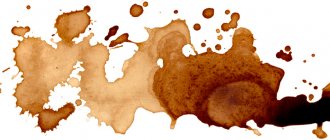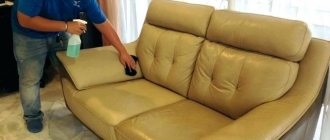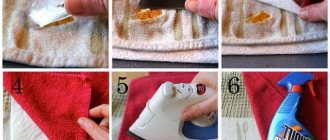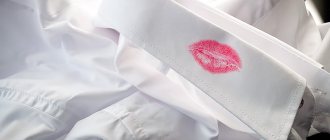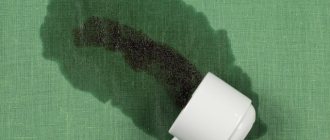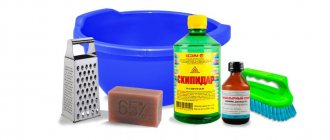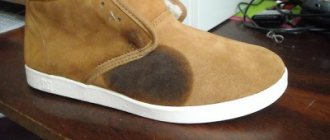A table covered with a snow-white tablecloth and beautifully set for the holiday creates the mood and the right atmosphere. But after a feast, various stains often remain: from appetizers, dessert, wine, candles.
The housewife is not always able to start cleaning right away, and later the fabric does not want to be washed. Do not rush to throw away the item; better find out how you can remove stains from a tablecloth using store-bought and folk remedies.
Wine stain types
Traces of wine can be removed using several methods, depending on the time that has passed since the contamination and the material.
- "Ambulance". Speed is the main condition for effectively combating red wine residues. As soon as an incident occurs, immediately blot the wine and gently wipe the area of contamination with a damp sponge. At the same time, you need to place several paper napkins under the fabric, and place a heavy object on top. This will allow all the moisture to be absorbed. In order not to scare away the guests, wait until they leave, and then soak the textiles in warm water with powder. After 30 minutes, rinse and later machine wash the machine.
- A wine stain on a white tablecloth can be removed with hydrogen peroxide. Dilute a teaspoon of peroxide in a glass of water, pour the resulting solution over the stains. Citric acid can be diluted in the same proportions. After such treatment, the white material must be rinsed and washed.
- You can also remove stains using traditional methods. This can be easily done with raw yolk mixed in equal proportions with glycerin. Rub the contaminated areas with this mixture, after which the material is rinsed and sent to the washing machine.
"Ambulance" for fresh contamination
It happens that during a feast drops of wine, fat, or sauce fall on the tablecloth. To simplify subsequent washing, it is recommended to immediately get rid of visible marks:
- sprinkle the stain with a small amount of table salt;
- apply a slurry of salt, which will absorb dirt; all that remains is to thoroughly wash the product;
- sprinkle with shavings of laundry soap. Another way: lightly rub the dirt with a bar;
- Cover the red wine stain with paper towels. Place a glass and a salad bowl on top so that the liquid is absorbed as much as possible into the loose paper. If you do this quickly, then only small traces will remain from the drops, which can then be easily washed off with powder or soap.
Beer residues on matter
If you are a beer drinker, then you need to figure out exactly how to wash a tablecloth from stains of this origin.
- Take ammonia and wipe the contaminated areas.
- Beer residue will remove the compound from 1 teaspoon of laundry soda per liter of liquid.
- A soap mixture of 5 g of soap + 0.5 spoons of soda + a glass of water will correct the situation. Immerse the coating in this mixture, leave it for a day, then wash it as usual.
- If after cleaning there are still blue or slightly purple traces left, boil the cloth by adding hydrogen peroxide.
Important! The method is applicable only for white laundry.
Leftover juice
- On colorful and artificial fabrics, a solution of 1 teaspoon of hot water + ½ teaspoon of ammonia + ½ teaspoon of hydrogen peroxide can deal with stains.
- Rub the area with soda slurry, then wash the material.
- Soak a linen or cotton tablecloth with the remaining juice in milk for an hour, then load the machine into the machine.
- If the contamination is fresh, then cut the lemon in half and rub it on the problem area.
Kerosene
But if gentle folk remedies do not help to cope with pollution, then you can correct the situation with the help of kerosene or household gasoline. These substances are suitable for particularly persistent and long-standing stains.
To remove stains, you must use only highly purified household gasoline. Regular automobile fuel is not suitable for these purposes. You can buy household gasoline at a hardware store.
The product is applied liberally and left for about 20-30 minutes. After this, the textiles are rinsed and washed well. It is best to air dry the product to remove the unpleasant odor.
Coffee and tea leftovers
- Heated 2 tablespoons of glycerin, in which a pinch of salt is dissolved, applied to the problem area will help. The fabric is then machine washed.
- Old tea stains on the tablecloth are cleaned with glycerin and ammonia in proportions 4/1. Treat the stain with the solution, leave for 30 minutes, place in the drum for washing.
Oily stains on textiles
- Greasy marks from the fabric are removed with a gruel made from potato flour. Dry a glass of flour in a frying pan, mix it with ½ glass of gasoline and treat the dirty area.
- Kerosene will remove yellow stains from oil or grease. However, traces of the kerosene itself will need to be washed with soapy water.
- Fresh traces are covered with ordinary kitchen salt for a couple of minutes. Periodically, the crystals are removed, after which a new portion is poured in. The operation continues in this way until the stain becomes completely light.
- Old greasy marks are cleaned with talc or chalk, which is poured onto the dirt, covered with a blotter and ironed. If you cannot completely remove it, then soak the cloth and leave the talc overnight.
- Remnants of lipstick most often remain on fabric napkins, which are included with the textile cover. Place the lipstick print on the paper towel. Walk over the problem area with a cotton swab dipped in makeup remover.
Talc
If the yellow stain is already old, and it remains from fat, then you can get rid of it with the help of talcum powder or crushed chalk.
The sequence of actions is as follows:
- The tablecloth is laid out on the ironing board.
- All affected areas are thickly sprinkled with talcum powder.
- Using blotting paper, the dirt is ironed with a hot iron.
- Finally, the tablecloth is washed with powder.
Each housewife has her own ways of bleaching table textiles. Choose a product that is at hand and begin the fight against unsightly stains that spoil the appearance of a snow-white, festive tablecloth.
It doesn’t matter if yellow stains appear on your down winter jacket after an unsuccessful wash. It happens that you have to wash vomit stains from upholstered furniture or clothes, and it is very difficult to clean a mattress from red stains and the smell of urine, but there are methods. You can, Removing stains is always a long and labor-intensive process, especially if it concerns traces of food or
Wax stains
After a romantic dinner, wax stains can ruin your mood for a long time. To prevent this from happening, you need to perform the following “machinations”.
- Remove the wax drops with a knife. Iron the remains, after placing several napkins under the fabric and on its surface.
- Removing smudges from a colored candle falls on the shoulders of the stain remover.
Drops of tomato and beets
- The removal procedure is quite simple. Wash off any spills with warm soapy water. If the dirt is not completely removed, sprinkle it with citric acid, leave for 5 minutes, and rinse.
- Traces of ketchup should not be immediately wiped off with a napkin, otherwise they may become permanently embedded in the fibers. Clean off the remaining sauce, turn the material inside out, placing it under running cold water. When finished, fill a basin with cool water and pour in a little liquid laundry detergent. Use a soft white cloth to moisten the dirt, then rinse the cloth in the basin. Repeat the procedure until the dirt from the sauce disappears.
White cotton cleaning
It is the most difficult to bleach a tablecloth from yellow stains. Over time and during use, the material turns yellow, which significantly spoils the overall appearance of the table covering. If you use household chemicals, the stains will recede, but the structure of the material will gradually begin to deteriorate. Proven folk methods can be used to bleach the color and preserve the fibers:
- Heat a couple of liters of milk so that you can hold your finger in it, place the yellowed item in the container, and leave it overnight. The next morning, take out the textiles, dry them in the shade, and wash them on a delicate cycle.
- Place the tissue in a solution of calcium wine salt and leave for 9 hours. This will refresh the matter.
- Aspirin will help remove matter. Dissolve 3 tablets in a glass of water. Pour the solution into a basin where the table cover has already been soaked, leave for an hour and a half, then transfer the fabric to the washing machine.
About ways to save tablecloths
There are several ways to clean tablecloths and linen napkins. All of them can be divided into 2 groups:
- Methods using modern detergents.
- Folk, time-tested methods of cleaning and bleaching natural fabrics.
The first group of methods for saving linen and cotton materials has recently become very common, since the synthetic substances included in washing powders and various bleaches make it possible to remove various stains from tablecloths in a short period of time and remove even not entirely fresh stains. However, aggressive chemical substances not only clean tabletops (also called tablecloths) from traces of dirt, but also destroy the material from which the products are made. After repeated bleaching and washing, the structure of natural things becomes thinner, and they tear faster and become unusable.
Some women combine washing powders with modern bleaches to achieve more effective results.
For this reason, many housewives prefer to use “grandmother’s” methods of cleaning and bleaching tablecloths, since the methods tested by housewives of more than one generation are more gentle on linen, and some of them are not inferior in cleaning quality to modern “chemistry”. Sometimes women, for greater effect, combine modern stain removers and powders with ancient methods of removing dirt during the washing and bleaching process. What is the best way to save your favorite tablecloth or napkins from stains and yellowing? Since the labels of modern detergents give detailed instructions for their use, there is no need to talk about them. But it wouldn’t hurt for every housewife to know some old tips for bleaching and cleaning natural materials, which are still successfully used all over the world.
You may be interested in: Proper kitchen installation
How to wash old marks
There are many fairly simple, but very effective methods to remove those contaminants that seemed to be ingrained into the fibers forever.
- Gasoline is a good tool in the fight against old persistent pollution. Soak a piece of tracing paper in gasoline, place it under the contaminated area, and wipe the dirt itself with a cotton pad soaked in gasoline, from the edges to the center. When finished, rinse the fabric in warm water.
- Apply potato starch, slightly moistened with hot water, to the dirty surface. Wait until it dries, then clean the machine in the machine.
- Apply laundry soap to the old dirt, soak the fabric in warm water overnight, and wash.
- To remove dirt on a tablecloth that has become deeply embedded in the fibers, boil 10 liters of water, add a cup of washing powder, 3 tablespoons of bleach and a few drops of vegetable oil. Bring the solution to a boil, soak the laundry and let cool. When finished, rinse in cold water.
Caring for Teflon fabric
A stain-resistant fabric that prevents liquids from penetrating deep into the fibers. Teflon impregnation is not felt to the touch, is extremely convenient to use and extends the service life of the material. Caring for this expensive material includes the following steps:
- Wipe the surface with a damp sponge daily.
- Washing is required once a month. The maximum temperature is 40 degrees, an important condition is no spin.
As you can see, it is possible to combat stains on a tablecloth, and quite successfully. By taking care of the cleaning in a timely manner, you will be ready to welcome your guests with dignity at any moment.
How to bleach linen fabric at home?
Linen has long been used to make clothing, because the natural fabric is environmentally friendly and does not cause allergic reactions or rashes. Due to the ability to allow air to pass through, the fabric allows the skin to breathe, which is a particularly important factor when choosing clothes.
In addition to its natural, positive properties, linen also has an attractive appearance. Light, light-colored fabric looks great as a sundress, light dress or men's trousers. Such clothing helps to reject the sun's rays and provides a feeling of comfort in hot weather.
In addition to clothing, linen fabric is usually used as decorative elements of the room. Kitchen curtains made of linen and formal tablecloths for dining or coffee tables are considered common. Linen has been used in everyday life for a long time, but it has gained particular popularity these days, when natural and environmentally friendly products have come into fashion.
Among the positive properties, it should be noted the wear resistance and strength of the fabric. Such clothes do not require special, intensive care, but will last for many years. The only thing that can happen to linen fabric is the disappearance of the rich white shade. But there are many options and methods to return your favorite item to its original appearance.
